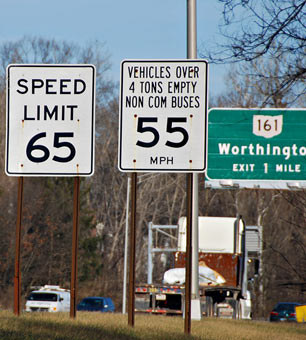Honest, paywall-free news is rare. Please support our boldly independent journalism with a donation of any size.
 (Photo: Gary Brown / Flickr)Moench proposes a way “to cut energy waste and reduce the nation’s emissions of greenhouse gases [that] is very simple, relatively painless and would actually save consumers money immediately, with no upfront costs.”
(Photo: Gary Brown / Flickr)Moench proposes a way “to cut energy waste and reduce the nation’s emissions of greenhouse gases [that] is very simple, relatively painless and would actually save consumers money immediately, with no upfront costs.”
In his State of the Union speech, President Obama said, in reference to the climate crisis, “If Congress won’t act soon to protect future generations, I will. I will direct my cabinet to come up with executive actions we can take, now and in the future, to reduce pollution, prepare our communities for the consequences of climate change, and speed the transition to more sustainable sources of energy.”
Last month, 70 environmental groups signed a letter to President Obama urging him to bypass Congress and use his executive authority to address the climate crisis in multiple ways. Key among those recommendations was yet another call to reject the Keystone Pipeline. As important as that is, there is even lower-hanging fruit that so far is being overlooked by the President and apparently forgotten by the environmental community.
The President specifically urged Americans to cut in half the energy wasted in homes and business over the next 20 years. One of the easiest and most benign ways to cut energy waste and reduce the nation’s emissions of greenhouse gases is very simple, relatively painless and would actually save consumers money immediately, with no upfront costs – restore a lower national freeway speed limit of 55 mph. It requires no technological innovation, merely a societal acceptance of the imperative to start reducing greenhouse gas emissions.
During World War II, Congress and President Franklin Roosevelt mandated a nationwide 35 mph speed limit. At the time, that was considered the most efficient speed for automobiles and would also preserve tires (Japan had cut off American access to natural rubber from Southeast Asia).
In 1973, Republican President Richard Nixon responded to the Arab Oil Embargo by mandating a drop in national freeway speed limits to 55 mph. Congress passed the corresponding legislation, the Emergency Highway Energy Conservation Act, setting the new national maximum speed limit. The act also prohibited the Department of Transportation from approving or funding any projects within states that did not comply with the new speed limit. That law lasted for over 21 years until 1995, when gasoline cost $1.10 a gallon, oil was $17 a barrel and global warming was just becoming a boutique topic of conversation. Obviously so much has changed since then.
Vehicles generally get the highest gas mileage somewhere between 45 and 55 mph, says David L. Greene of the National Transportation Research Center at Oak Ridge National Laboratory in Knoxville, Tennessee. Doubling speed from 40 to 80 mph increases drag resistance fourfold.
In 2009, Consumer Reports tested seven different models of cars. The average drop in fuel efficiency was 25% when speeds were increased from 55 to 75 mph. Nationwide implementation of such a speed limit drop would decrease American oil consumption about 4%, or 280 million barrels a year [1]. That is more than currently comes from the Alaska Pipeline and about the same as the Keystone Pipeline would carry at full capacity.
While no one expects the current Congress to pass any such law, given the paralysis inflicted by the House Republicans’ allergy to science, several court rulings have upheld the EPA’s power to regulate greenhouse gases (GHG) from multiple sources. Fuel efficiency standards for mobile sources have been established in Section 202 of the Clean Air Act (CAA). The basis for those regulations were upheld by the Supreme Court in a 2007 ruling that “greenhouse gases fit well within the Act’s capacious definition of ‘air pollutant'” and that EPA therefore has statutory authority to regulate GHG emissions from new motor vehicles.
In June 2012 and again in December 2012, the United States Court of Appeals for the District of Columbia upheld the EPA’s authority to regulate GHG emissions.
If the EPA has the authority to regulate fuel efficiency and GHG related to the manufacturing of motor vehicles, then it should also have the authority to establish a national speed limit to address those same issues during the use of those vehicles.
If winning World War II and the Arab oil embargo were sufficient reasons to lower national speed limits, then avoiding the climate crisis should be an even more compelling reason to do so.
Rejecting the Keystone Pipeline would not only defuse the “carbon bomb” that is the Alberta Tar Sands, it is also a symbolic “line in the sand” that we will not allow the fossil fuel industry to cross in pursuit of profits. Also lowering speed limits will symbolize that neither will we allow our own continued profligate use of fossil fuels to go unchecked. Both will be necessary to avoid a planet too hostile for the survival of modern civilization.
Note:
1. “Saving Oil in a Hurry: Oil Demand Restraint in Transport,” by International Energy Agency, Workshop: Managing Oil Demand in Transport, Paris, 7-8 March, 2005
Media that fights fascism
Truthout is funded almost entirely by readers — that’s why we can speak truth to power and cut against the mainstream narrative. But independent journalists at Truthout face mounting political repression under Trump.
We rely on your support to survive McCarthyist censorship. Please make a tax-deductible one-time or monthly donation.
